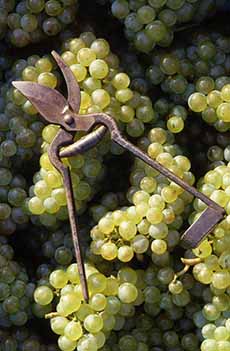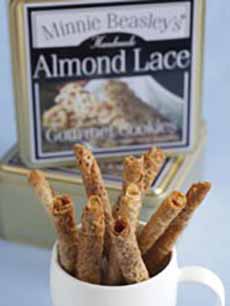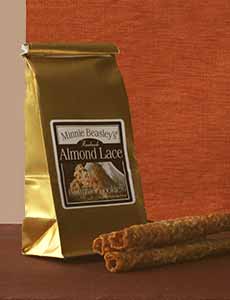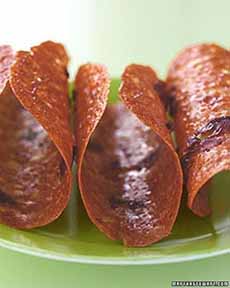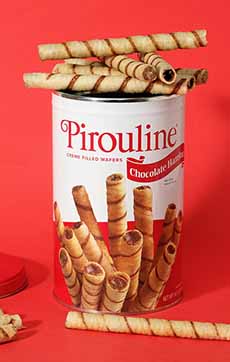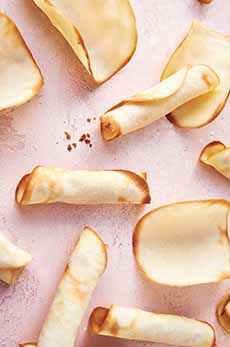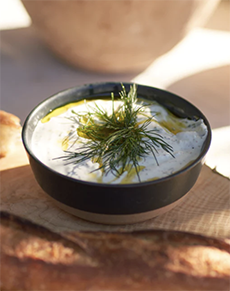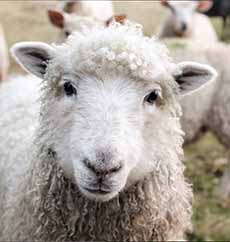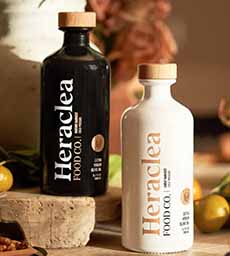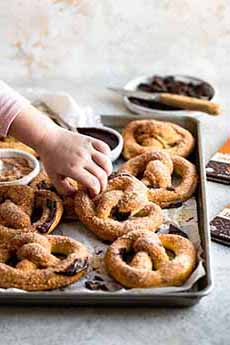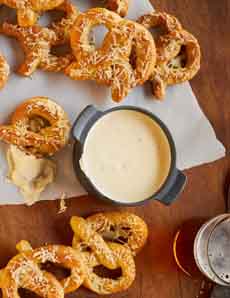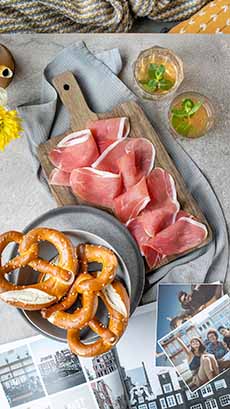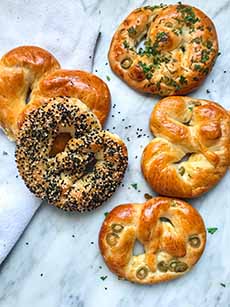|
Way back in 2007, THE NIBBLE wrote enthusiastically about Minnie Beasley’s almond lace cookies, buttery, lacy almond toffee cookies. They won a gold medal as “best cookie” at the Fancy Food Show the following year, but we subsequently lost touch with the brand.
We were pleased to receive an email from them recently proclaiming, “We’re back!”
This means that you, too, can know the joy of Minnie Beasley’s Almond Lace Cookies*, thanks to her great-nephew Harmon Beasley Canon.
And keeping up with the times, there Minnie Beasley’s also are available gluten-free.
The cookies (photos #1 and #2) are a delicate gourmet confection, a special treat, a hybrid of a lace cookie (photo #4) and a pirouette cookie (photos #5, #6, and #7). See the section below for an elucidation.
Lace cookies are a Southern specialty, and Southern ladies created them in different ways.
Lady Bird Johnson, for example, was known for her recipe†, a flat lace cookie. Aunt Minnie’s cookies were—and are—rolled, pirouette-style, and contain almonds.
You can find still other recipes online.
MINNIE BEASLEY & HER COOKIES
Great Aunt Minnie lived with Harmon Canon’s family during his boyhood in Memphis. As Mr. Canon relates:
“She blessed us with a wealth of wisdom and love as well as giving us this wonderful recipe.” She made them every year at Christmas, a family holiday favorite (the kids would fight over them).
After Minnie’s passing, Mr. Canon’s mother made the almond toffee cookies for the holidays.
When Mr. Canon moved from Memphis to Denver in 2003, it became his turn to bake the cookies at Christmas. He later began to sell them at retail, urged on by the ardent enthusiasm of recipients.
The cookies are made completely by hand. It’s a labor-intensive process.
The dough comes out of the oven flat and paper-thin, and each cookie must be hand-rolled before it cools.
While they look like they might stick to your teeth, they don’t; they melt in your mouth. Anyone’s great aunt can nibble away to her heart’s delight.
Following success with Denver-area retailers, Mr. Canon began to sell to retailers nationwide, and direct to consumers via the Minnie Beasley’s website.
The good news is, you can have them year-round: no waiting for the holidays.
WAYS TO ENJOY MINNIE BEASLEY’S COOKIES
You certainly can see these cookies being served at tea parties in Memphis, enjoyed by fine ladies in hats and white gloves.
You can dress up if you like. Or not.
Enjoy Minnie Beasley’s Almond Lace Cookies:
With your favorite comfort beverage: tea, coffee, hot chocolate, or milk.
With a glass of sherry or sweet wine.
On an assorted dessert or cookie plate.
With ice cream, frozen yogurt, or sorbet.
With fruit salad or fruit compote.
As a garnish with other desserts—mousse, pudding, etc.
The cookies can be frozen if they aren’t consumed within a few weeks, but one would have to be on a serious diet to resist consuming the box (sharing with worthy friends and loved ones, of course).
GET YOUR LACE COOKIES
Almond Lace Cookies are $13.85 per 6-ounce bag, slightly more for gluten-free. Order 10 Bags and get FREE shipping—just in time for Mother’s Day.
Head to MinnieBeasleys.com to place your order.
MINNIE BEASLEY’S COOKIES ARE PIROUETTES, NOT TUILES
Minnie Beasley’s calls their almond lace cookies tuiles. That’s not entirely accurate. The slender cigarette shape is a pirouette (photos #5, #6, and #7).
Many food experts make this mistake. So please hear this: A cookie needs to be shaped like a curved rooftop tile to be called a tuile.
Tuiles, the French word for tiles, are the curved rooftop tiles of the Provence region of France (photo #3). Tuiles have some form of U shape—a narrow opening like photo #3, or a much broader one like this or like this.
Lace cookies themselves can be flat (photo #4), tuile-shaped (photo #3), or rolled into cigarette-shape pirouettes (photo #2). There are even cone shapes. The differentiator is that the texture is lacy.
Here are three different shapes of lace cookies: cone, pirouette, and tuile.
Any of these shapes scan have a lacy texture or be solid, thin dough. If the dough is solid, they aren’t lace cookies (photo #7).
> The history of cookies.
> The different styles of cookies.
> The different types of cookies.
THE HISTORY OF PIROUETTE COOKIES
Pirouette cookies are rolled wafer cookies. Versions exist all over Europe.
Around 1860, the DeBeukelaer family of Belgium launched a cookie business, the 1st Biscuit and Wafer Co. The company later claimed to have invented the rolled wafer cookie.
We can’t find a history of that company, but in 1978, Peter DeBeukelaer, a descendant, founded DBC Corporation, also operating as DeBeukelaer Corporation and the DeBeukelaer Cookie Co.
That same year, the company trademarked the Pirouline Swirl, a rolled wafer cookie with a contrasting edge (photo #5).
Americans may be more familiar with Pepperidge Farm’s Pirouette cookies (photo #6), which were likely discovered in Europe by Margaret Rudkin, the company’s founder.
The company website noted that she went on a “tasting trip” to Europe in the 1950s in search of distinctive cookies that were “delicate in flavor and texture” to add to her line.
Perhaps she stumbled over Piroulines (photo #5).
Many cuisines have their version of a rolled wafer cookie.
The French call them pirouettes because they are rolled or twirled, suggesting a pirouette in dance.
In Norway, they are known as krumkake, often rolled with raised patterns in the dough.
In the Czech Republic, they are called Parisian cookies (parizske pecivo).
The Philippines adopted the rolled cookies from Spain, where they are known as barquillos.
|





